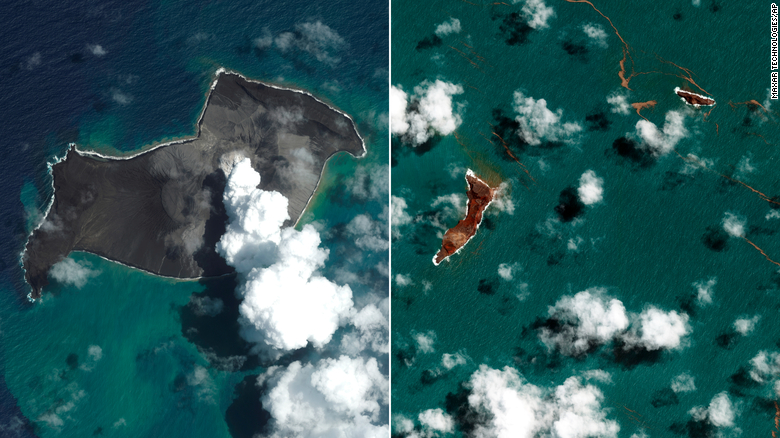Tonga volcano eruption sent "hurricane" into space 0:52
(CNN) --
The volcanic eruption on an island near Tonga in January was as powerful as Indonesia's 1883 eruption of Krakatoa, one of the deadliest and most destructive volcanic events on record.
Scientists have begun to piece together what happened during the eruption of the Hunga Tonga-Hunga Ha'apai underwater volcano on January 15, about 65 kilometers north of Tonga's capital, which killed at least three people.
The eruption has defied easy explanation and turned scientists' understanding of this type of volcano upside down.
Volcano eruption near Tonga was 'hundreds of times' stronger than Hiroshima atomic bomb, NASA says
The volcanic eruption sent rarely observed pressure waves around the world for six days and unleashed an unexpected tsunami wave, according to two new studies published Thursday in the journal Science.
The huge plume of gases, water vapor and dust also created hurricane-force winds in space, NASA said in a separate study published this week.
Early data from the blast suggested it was the largest since the 1991 eruption of Mount Pinatubo in the Philippines, but studies in Science, involving 76 scientists in 17 countries, suggested the pressure waves it unleashed were similar to those generated by the cataclysmic 1883 Krakatoa eruption and 10 times larger than those of the 1980 Mount St. Helens eruption in Skamania County, Washington.
"Unusually energetic"
The Tonga eruption was "unusually energetic," the Science study researchers wrote.
Low-frequency atmospheric pressure waves, called Lamb waves, that were detected after the eruption circled the planet four times in one direction and three times in the opposite direction, they revealed.
A relatively rare phenomenon, these waves travel at the speed of sound.
They are not detectable by humans and are slower than shock waves as they have sometimes been misdescribed, said study author Quentin Brissaud, a geophysicist with the Norwegian Seismic Array in Oslo.
Lamb waves were also observed during the Cold War after atmospheric nuclear tests.
What are underwater volcanoes like the one that erupted in Tonga?
"It's quite rare. So Lamb waves are really related to large volume displacements of air. And they mostly propagate along the Earth's surface," said co-author Jelle Assink, a senior geophysicist in the department. of seismology and acoustics of the Royal Netherlands Meteorological Institute.
Moving across the surface of multiple oceans and seas, Lamb pressure waves from the explosion created an avalanche of fast-moving, scattered tsunamis.
Traditional tsunamis are usually related to sudden changes in the ocean floor, such as during an earthquake.
Crucially, these so-called meteotsunamis travel much faster than traditional tsunamis, arrive two hours earlier than expected, and last longer, which could have implications for early warning systems.
And because an atmospheric pressure wave generated them, the tidal waves appeared to "skip continents," with tsunamis recorded from the Pacific to the Atlantic, said co-author Silvio De Angelis, a professor of volcano geophysics in the department of Ecological Sciences at Earth and Ocean at the University of Liverpool in the UK.
The investigation also revealed that the audible sound of the eruption was detected more than 10,000 kilometers from the source in Alaska, where it was heard as a series of booms.
Krakatoa's 1883 eruption was heard 3,000 miles away, according to the study, though it was less systematically reported than Tonga's.
A lithograph illustrates the clouds pouring from the Krakatoa volcano during the catastrophic 1883 eruption in southwestern Indonesia.
The researchers said more data was needed to understand the mechanism of the eruption.
It is believed that one of the reasons for such an energetic explosion, which created an umbrella cloud 30 kilometers high and a plume some 58 kilometers high, was because "hot, gas-laden magma came into contact with the (water of sea) very quickly," De Angelis said by email.
"The rapid transfer of intense heat between hot magma and cold water causes violent explosions capable of tearing apart the magma."
space disturbance
Another study, published Tuesday in Geophysical Research Letters, found that the Tonga volcano also wreaked havoc in space, causing hurricane-force winds, according to data from NASA's Ionospheric Connection Explorer, or ICON, mission and the Space Agency's Swarm satellites. European.
The giant plume of gases, water vapor and dust pushed into the sky by the eruption created huge pressure disturbances in the atmosphere, triggering strong winds, NASA said in a statement.
As these winds expanded into thinner layers of the atmosphere, they began to move faster.
"Upon reaching the ionosphere and the edge of space, ICON recorded wind speeds of up to 724 km/h, making them the strongest winds below 193 km altitude measured by the mission since launch," NASA said.
(From left) Satellite images from January 6 and 18 show the impact of volcanic eruptions near Tonga.
In the ionosphere, where Earth's atmosphere meets space, extreme winds also whipped up electrical currents, flipping particles of their usual east-flowing electrical current, called an equatorial electrojet, westward for a brief period, and the electroblast increased five times its normal maximum power.
"It's very surprising to see that the electrojet is largely reversed by something that happened on the Earth's surface," said Joanne Wu, a physicist at the University of California, Berkeley, and co-author of the new Geophysical Research Letters study.
"This is something we've only seen before with strong geomagnetic storms, which are a form of weather in space caused by particles and radiation from the sun."
Brian Harding, a physicist at UC Berkeley and lead author, said the Tonga eruption "allowed us to test the little-known connection between the lower atmosphere and space."
"The volcano created one of the largest disturbances in space that we have seen in the modern era," he added.
volcano tonga





